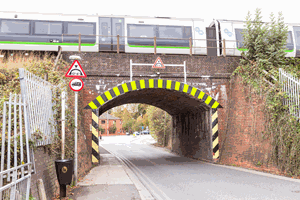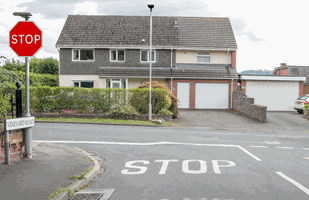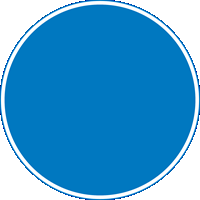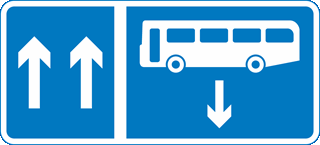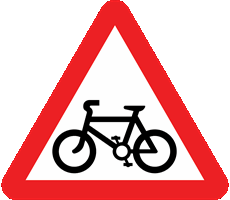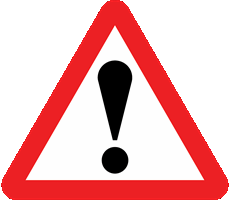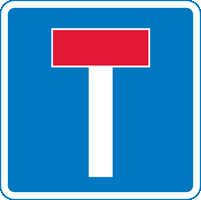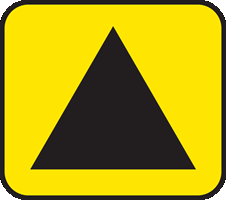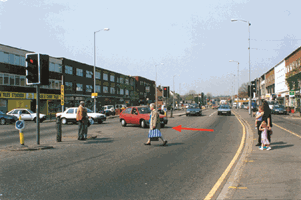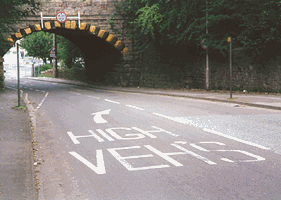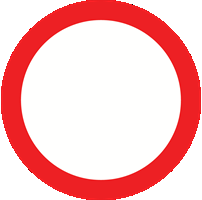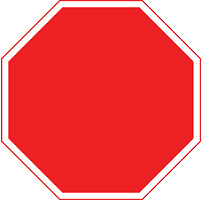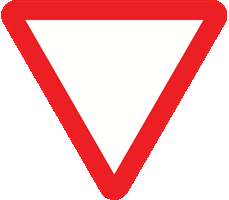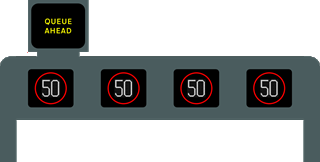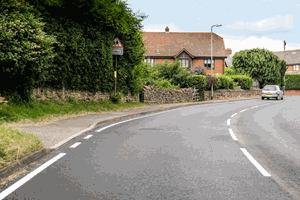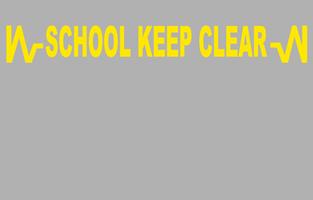You have 57 minutes to answer 50 multiple choice driving theory test questions. You need to answer at least 43 out of 50 questions correctly to pass. You can review your answer after each question or you can review all of your answers at the end of the test. Best of luck!
Test Quick View
Click on an answer to view the correct choice along with the explanation.
Correct Answer: B
Explanation: The safest option is to switch off your mobile phone before you set off, and use a message service. Even hands-free systems are likely to distract your attention. Don't endanger other road users. If you need to make a call, pull up in a safe place when you can, you may need to go some distance before you can find one. It's illegal to use a hand-held mobile or similar device when driving or riding, except in a genuine emergency.
Explanation: The safest option is to switch off your mobile phone before you set off, and use a message service. Even hands-free systems are likely to distract your attention. Don't endanger other road users. If you need to make a call, pull up in a safe place when you can, you may need to go some distance before you can find one. It's illegal to use a hand-held mobile or similar device when driving or riding, except in a genuine emergency.
چلنے سے پہلے محفوظ ترین طریقہ یہ ہے کہ اپنا موبائل فون بند کرلیں اور میسیج سسٹم کا استعمال کریں۔ حتی کہ ہینڈز فری سسٹم بھی آپ کی توجہ ہٹا سکتا ہے۔ سڑک پر دوسرے لوگوں کو خطرے میں مت ڈالیں۔ اگر آپ کو کال کرنے کی ضرورت ہے تو کسی محفوظ مقام پر رکیں۔ اس سے پہلے کہ آپ کو کوئی ایسا مقام ملے کہ آپ کو کچھ فاصلہ طے کرنا پڑسکتا ہے ماسوائے حقیقی ایمرجنسی کے یہ غیر قانونی ہے کہ گاڑی چلنے یا سواری کرتے ہوئے ہاتھ میں پکڑنے والا موبائل یا اس جیسا کوئی دوسرا آلہ استعمال کیا جائے۔
Correct Answer: D
Explanation: Every effort must be made to prevent excessive noise, especially in built-up areas at night. Don't rev your engine or sound the horn unnecessarily. It's illegal to sound your horn in a built-up area between 11.30 pm and 7.00 am, except when another road user poses a danger.
Explanation: Every effort must be made to prevent excessive noise, especially in built-up areas at night. Don't rev your engine or sound the horn unnecessarily. It's illegal to sound your horn in a built-up area between 11.30 pm and 7.00 am, except when another road user poses a danger.
Correct Answer: C
Explanation: Traffic-calming measures help to keep vehicle speeds low in congested areas where there are pedestrians and children. A pedestrian is much more likely to survive a collision with a vehicle travelling at 20 mph than they are with a vehicle travelling at 40 mph.
Explanation: Traffic-calming measures help to keep vehicle speeds low in congested areas where there are pedestrians and children. A pedestrian is much more likely to survive a collision with a vehicle travelling at 20 mph than they are with a vehicle travelling at 40 mph.
Correct Answer: C
Explanation: The highest point of the bridge is in the centre, so a large vehicle might have to move to the centre of the road to have enough room to pass under the bridge.
Explanation: The highest point of the bridge is in the centre, so a large vehicle might have to move to the centre of the road to have enough room to pass under the bridge.
Correct Answer: A
Explanation: The 'stop' sign has been put here because the view into the main road is poor. You must stop because it won't be possible to take proper observation while you're moving.
Explanation: The 'stop' sign has been put here because the view into the main road is poor. You must stop because it won't be possible to take proper observation while you're moving.
Correct Answer: D
Explanation: You must obey signals to stop given by police and traffic officers, traffic wardens and school crossing patrols. Failure to do so is an offence and could lead to prosecution.
Explanation: You must obey signals to stop given by police and traffic officers, traffic wardens and school crossing patrols. Failure to do so is an offence and could lead to prosecution.
Correct Answer: B
Explanation: The 'no right turn' sign may be used to warn road users that there's a 'no entry' prohibition on a road to the right ahead.
Explanation: The 'no right turn' sign may be used to warn road users that there's a 'no entry' prohibition on a road to the right ahead.
Correct Answer: A
Explanation: Signs with blue circles mostly give a positive instruction. These are often found in urban areas and include signs for mini-roundabouts and directional arrows.
Explanation: Signs with blue circles mostly give a positive instruction. These are often found in urban areas and include signs for mini-roundabouts and directional arrows.
Correct Answer: B
Explanation: There will also be markings on the road surface to indicate the bus lane. You mustn't use this lane for parking or overtaking.
Explanation: There will also be markings on the road surface to indicate the bus lane. You mustn't use this lane for parking or overtaking.
Correct Answer: B
Explanation: Where there's a cycle route ahead, a sign will show a bicycle in a red warning triangle. Watch out for children on bicycles and cyclists rejoining the main road.
Explanation: Where there's a cycle route ahead, a sign will show a bicycle in a red warning triangle. Watch out for children on bicycles and cyclists rejoining the main road.
Correct Answer: A
Explanation: This sign is there to alert you to the likelihood of danger ahead. It may be accompanied by a plate indicating the type of hazard. Be ready to reduce your speed and take avoiding action.
Explanation: This sign is there to alert you to the likelihood of danger ahead. It may be accompanied by a plate indicating the type of hazard. Be ready to reduce your speed and take avoiding action.
Correct Answer: A
Explanation: You won't be able to find a through route to another road. Use this road only for access.
Explanation: You won't be able to find a through route to another road. Use this road only for access.
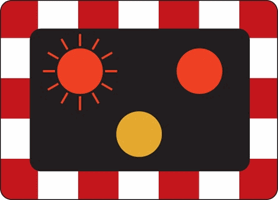
B
C
D
Correct Answer: A
Explanation: These signals are found at level crossings, swing or lifting bridges, some airfields and emergency access sites. The flashing red lights mean stop whether or not the way seems to be clear.
Explanation: These signals are found at level crossings, swing or lifting bridges, some airfields and emergency access sites. The flashing red lights mean stop whether or not the way seems to be clear.
Correct Answer: A
Explanation: You must obey signals given by the police. If a police officer in a patrol vehicle wants you to pull over, they'll indicate this without causing danger to you or other traffic.
Explanation: You must obey signals given by the police. If a police officer in a patrol vehicle wants you to pull over, they'll indicate this without causing danger to you or other traffic.
Correct Answer: B
Explanation: When a diversion route has been put in place, drivers are advised to follow a symbol, which may be a black triangle, square, circle or diamond shape on a yellow background.
Explanation: When a diversion route has been put in place, drivers are advised to follow a symbol, which may be a black triangle, square, circle or diamond shape on a yellow background.
16. It's essential that tyre pressures are checked regularly. When should this be done? Mark one answer
AB
C
D
Correct Answer: C
Explanation: Check the tyre pressures when the tyres are cold. This will give you a more accurate reading. The heat generated on a long journey will raise the pressure inside the tyre.
Explanation: Check the tyre pressures when the tyres are cold. This will give you a more accurate reading. The heat generated on a long journey will raise the pressure inside the tyre.
17. You're travelling behind a moped. What should you do when you want to turn left just ahead? Mark one answer
AB
C
D
Correct Answer: D
Explanation: Passing the moped and turning into the junction could mean that you cut across the front of the rider. This might force them to slow down, stop or even lose control. Stay behind the moped until it has passed the junction and then you can turn without affecting the rider.
Explanation: Passing the moped and turning into the junction could mean that you cut across the front of the rider. This might force them to slow down, stop or even lose control. Stay behind the moped until it has passed the junction and then you can turn without affecting the rider.
Correct Answer: C
Explanation: Some people might take a long time to cross the road. They may be older or have a disability. Be patient and don't hurry them by showing your impatience. If pedestrians are standing at the side of the road, don't signal or wave them to cross. Other road users might not have seen your signal and this could lead the pedestrians into a hazardous situation.
Explanation: Some people might take a long time to cross the road. They may be older or have a disability. Be patient and don't hurry them by showing your impatience. If pedestrians are standing at the side of the road, don't signal or wave them to cross. Other road users might not have seen your signal and this could lead the pedestrians into a hazardous situation.
Correct Answer: A
Explanation: Oncoming large vehicles may need to move to the middle of the road to pass safely under the bridge. There won't be enough room for you to continue, so you should be ready to stop and wait.
Explanation: Oncoming large vehicles may need to move to the middle of the road to pass safely under the bridge. There won't be enough room for you to continue, so you should be ready to stop and wait.
20. A police car is following you. The police officer flashes the headlights and points to the left. What should you do? Mark one answer
AB
C
D
Correct Answer: B
Explanation: You must pull up on the left as soon as it's safe to do so and switch off your engine.
Explanation: You must pull up on the left as soon as it's safe to do so and switch off your engine.
Correct Answer: D
Explanation: Other warning signs are the same shape and colour, but the 'give way' triangle points downwards. When you see this sign, you must give way to traffic on the road that you're about to enter.
Explanation: Other warning signs are the same shape and colour, but the 'give way' triangle points downwards. When you see this sign, you must give way to traffic on the road that you're about to enter.
Correct Answer: C
Explanation: When you see this sign, look out for any direction signs and judge whether you need to signal your intentions. Do this in good time so that other road users approaching the roundabout know what you're planning to do.
Explanation: When you see this sign, look out for any direction signs and judge whether you need to signal your intentions. Do this in good time so that other road users approaching the roundabout know what you're planning to do.
Correct Answer: A
Explanation: The hard shoulder should only be used in a genuine emergency. If possible, and if it's safe, use a roadside telephone to call for help. This will give your exact location to the operator. Never cross the carriageway or a slip road to use a telephone on the other side of the road.
Explanation: The hard shoulder should only be used in a genuine emergency. If possible, and if it's safe, use a roadside telephone to call for help. This will give your exact location to the operator. Never cross the carriageway or a slip road to use a telephone on the other side of the road.
A
B
C
D
B
C
D
Correct Answer: D
Explanation: Other drivers or riders may have to change course due to the size or characteristics of their vehicle. Understanding this will help you to anticipate their actions. Motorcyclists and cyclists will be checking the road ahead for uneven or slippery surfaces, especially in wet weather. They may need to move across their lane to avoid surface hazards such as potholes and drain covers.
Explanation: Other drivers or riders may have to change course due to the size or characteristics of their vehicle. Understanding this will help you to anticipate their actions. Motorcyclists and cyclists will be checking the road ahead for uneven or slippery surfaces, especially in wet weather. They may need to move across their lane to avoid surface hazards such as potholes and drain covers.
25. Who's legally responsible for ensuring that a vehicle registration certificate (V5C) is updated? Mark one answer
AB
C
D
Correct Answer: B
Explanation: It's your legal responsibility to keep the details on your vehicle registration certificate (V5C) up to date. You should tell the licensing authority about any changes. These include your name, address or vehicle details. If you don't do this, you may have problems when you try to sell your vehicle.
Explanation: It's your legal responsibility to keep the details on your vehicle registration certificate (V5C) up to date. You should tell the licensing authority about any changes. These include your name, address or vehicle details. If you don't do this, you may have problems when you try to sell your vehicle.
Correct Answer: A
Explanation: You must obey mandatory speed-limit signs above motorway lanes, including the hard shoulder. In this case, you can use the hard shoulder as a running lane but you should look for any vehicles that may have broken down and may be blocking the hard shoulder.
Explanation: You must obey mandatory speed-limit signs above motorway lanes, including the hard shoulder. In this case, you can use the hard shoulder as a running lane but you should look for any vehicles that may have broken down and may be blocking the hard shoulder.
27. You're going through a long tunnel. What will warn you of congestion or an incident ahead? Mark one answer
AB
C
D
Correct Answer: D
Explanation: Follow the instructions given by the signs or by tunnel officials. In congested tunnels, a minor incident can soon turn into a major one, with serious or even fatal results.
Explanation: Follow the instructions given by the signs or by tunnel officials. In congested tunnels, a minor incident can soon turn into a major one, with serious or even fatal results.
28. At an incident, a casualty is unconscious but breathing. When should you move them? Mark one answer
AB
C
D
Correct Answer: D
Explanation: Don't move a casualty unless there's further danger; for example, from other traffic or fire. They may have unseen or internal injuries. Moving them unnecessarily could cause further injury. Don't remove a motorcyclist's helmet unless it's essential.
Explanation: Don't move a casualty unless there's further danger; for example, from other traffic or fire. They may have unseen or internal injuries. Moving them unnecessarily could cause further injury. Don't remove a motorcyclist's helmet unless it's essential.
29. A collision has just happened. An injured person is lying in a busy road. What's the first thing you should do to help? Mark one answer
AB
C
D
Correct Answer: D
Explanation: The most immediate danger is further collisions and fire. You could warn other traffic by switching on hazard warning lights, displaying an advance warning triangle or sign (but not on a motorway), or by any other means that doesn't put you or others at risk.
Explanation: The most immediate danger is further collisions and fire. You could warn other traffic by switching on hazard warning lights, displaying an advance warning triangle or sign (but not on a motorway), or by any other means that doesn't put you or others at risk.
A
B
C
D
B
C
D
Correct Answer: C
Explanation: When someone is injured, any movement that isn't absolutely necessary should be avoided, since it could make the injuries worse. Unless it's essential to remove a motorcyclist's helmet, it's generally safer to leave it in place.
Explanation: When someone is injured, any movement that isn't absolutely necessary should be avoided, since it could make the injuries worse. Unless it's essential to remove a motorcyclist's helmet, it's generally safer to leave it in place.
Correct Answer: A
Explanation: Skidding is usually caused by driver error. You should always adjust your driving to take account of the road and weather conditions.
Explanation: Skidding is usually caused by driver error. You should always adjust your driving to take account of the road and weather conditions.
32. You're about to go down a steep hill. What should you do to control the speed of your vehicle? Mark one answer
AB
C
D
Correct Answer: D
Explanation: When driving down a steep hill, gravity will cause your vehicle to speed up. This will make it more difficult for you to stop. To help keep your vehicle's speed under control, select a lower gear to give you more engine braking and make careful use of the brakes.
Explanation: When driving down a steep hill, gravity will cause your vehicle to speed up. This will make it more difficult for you to stop. To help keep your vehicle's speed under control, select a lower gear to give you more engine braking and make careful use of the brakes.

B
C
D
Correct Answer: A
Explanation: Hold back and allow the cyclist to move off. Some junctions have special areas marked across the front of the traffic lane. These allow cyclists to wait for the lights to change and move off ahead of other traffic.
Explanation: Hold back and allow the cyclist to move off. Some junctions have special areas marked across the front of the traffic lane. These allow cyclists to wait for the lights to change and move off ahead of other traffic.
Correct Answer: D
Explanation: You may remove your seat belt while you're carrying out a manoeuvre that includes reversing. However, you must remember to put it back on again before you resume driving.
Explanation: You may remove your seat belt while you're carrying out a manoeuvre that includes reversing. However, you must remember to put it back on again before you resume driving.
Correct Answer: D
Explanation: A continuous white line is used on many roads to indicate the edge of the carriageway. This can be useful when visibility is restricted. The line is discontinued at junctions, lay-bys, and entrances to or exits from private drives.
Explanation: A continuous white line is used on many roads to indicate the edge of the carriageway. This can be useful when visibility is restricted. The line is discontinued at junctions, lay-bys, and entrances to or exits from private drives.
36. Turning the steering wheel while stationary can cause damage to which part of your car? Mark one answer
AB
C
D
Correct Answer: D
Explanation: Turning the steering wheel when the car isn't moving is known as dry steering. It can cause unnecessary wear to the tyres and steering mechanism.
Explanation: Turning the steering wheel when the car isn't moving is known as dry steering. It can cause unnecessary wear to the tyres and steering mechanism.
Correct Answer: A
Explanation: If you have to leave valuables in your car, lock them out of sight. This is the best way to deter an opportunist thief.
Explanation: If you have to leave valuables in your car, lock them out of sight. This is the best way to deter an opportunist thief.
Correct Answer: A
Explanation: You shouldn't stop on yellow zigzag lines outside schools, not even to set down or pick up children or other passengers. This is to make sure passing drivers and pedestrians have an unobstructed view.
Explanation: You shouldn't stop on yellow zigzag lines outside schools, not even to set down or pick up children or other passengers. This is to make sure passing drivers and pedestrians have an unobstructed view.
Correct Answer: A
Explanation: If you have a garage, use it. Your vehicle is less likely to be a victim of car crime if it's in a garage. Also, in winter, the windows will be kept free from ice and snow.
Explanation: If you have a garage, use it. Your vehicle is less likely to be a victim of car crime if it's in a garage. Also, in winter, the windows will be kept free from ice and snow.
40. You're on a motorway at night, with other vehicles just ahead of you. Which lights should you have on? Mark one answer
AB
C
D
Correct Answer: A
Explanation: If you're driving behind other traffic on the motorway at night, use dipped headlights. Main-beam headlights will dazzle the other drivers. Your headlights' dipped beam should fall short of the vehicle in front.
Explanation: If you're driving behind other traffic on the motorway at night, use dipped headlights. Main-beam headlights will dazzle the other drivers. Your headlights' dipped beam should fall short of the vehicle in front.
A
B
C
D
B
C
D
Correct Answer: D
Explanation: Always use your headlights at night on a motorway unless you've had to stop on the hard shoulder. If you break down and have to use the hard shoulder, switch off your headlights but leave your sidelights on, so that other road users can see your vehicle.
Explanation: Always use your headlights at night on a motorway unless you've had to stop on the hard shoulder. If you break down and have to use the hard shoulder, switch off your headlights but leave your sidelights on, so that other road users can see your vehicle.
42. You're driving on a motorway. The car in front shows its hazard warning lights for a short time. What does this tell you? Mark one answer
AB
C
D
Correct Answer: D
Explanation: If the vehicle in front shows its hazard warning lights, there may be an incident, stopped traffic or queuing traffic ahead. By keeping a safe distance from the vehicle in front, you're able to look beyond it and see any hazards well ahead.
Explanation: If the vehicle in front shows its hazard warning lights, there may be an incident, stopped traffic or queuing traffic ahead. By keeping a safe distance from the vehicle in front, you're able to look beyond it and see any hazards well ahead.
43. You've broken down on a motorway. When you use the emergency telephone, what will you be asked for? Mark one answer
AB
C
D
Correct Answer: A
Explanation: Have the correct details ready before you use the emergency telephone. The operator will need to know the details of your vehicle and its fault. For your own safety, always face the traffic when you speak on a roadside telephone.
Explanation: Have the correct details ready before you use the emergency telephone. The operator will need to know the details of your vehicle and its fault. For your own safety, always face the traffic when you speak on a roadside telephone.
44. You're driving in busy traffic. You want to pull up on the left just after a junction on the left. When should you signal? Mark one answer
AB
C
D
Correct Answer: A
Explanation: You need to signal to let other drivers know your intentions. However, if you indicate too early, they may think you're turning left into the junction. Correct timing of the signal is very important to avoid misleading others.
Explanation: You need to signal to let other drivers know your intentions. However, if you indicate too early, they may think you're turning left into the junction. Correct timing of the signal is very important to avoid misleading others.
Correct Answer: A
Explanation: Hazard warning lights are an important safety feature. Use them when driving on a motorway to warn traffic behind you of danger ahead. You should also use them if your vehicle has broken down and is causing an obstruction.
Explanation: Hazard warning lights are an important safety feature. Use them when driving on a motorway to warn traffic behind you of danger ahead. You should also use them if your vehicle has broken down and is causing an obstruction.
Correct Answer: C
Explanation: The interior mirror of most vehicles can be set to an anti-dazzle position. You'll still be able to see the lights of the traffic behind you, but the dazzle will be greatly reduced.
Explanation: The interior mirror of most vehicles can be set to an anti-dazzle position. You'll still be able to see the lights of the traffic behind you, but the dazzle will be greatly reduced.
Correct Answer: D
Explanation: If your rear fog lights are left on when it isn't foggy, the glare they cause makes it difficult for road users behind to know whether you're braking or you've just forgotten to turn off your rear fog lights. This can be a particular problem on wet roads and on motorways. If you leave your rear fog lights on at night, road users behind you are likely to be dazzled and this could put them at risk.
Explanation: If your rear fog lights are left on when it isn't foggy, the glare they cause makes it difficult for road users behind to know whether you're braking or you've just forgotten to turn off your rear fog lights. This can be a particular problem on wet roads and on motorways. If you leave your rear fog lights on at night, road users behind you are likely to be dazzled and this could put them at risk.
Correct Answer: A
Explanation: Competitive driving increases the risks to everyone and is the opposite of responsible, considerate and defensive driving. Defensive driving is about questioning the actions of other road users and being prepared for the unexpected. Don't be taken by surprise.
Explanation: Competitive driving increases the risks to everyone and is the opposite of responsible, considerate and defensive driving. Defensive driving is about questioning the actions of other road users and being prepared for the unexpected. Don't be taken by surprise.
Correct Answer: C
Explanation: After passing your practical driving test, you can take further training. One option is known as the Pass Plus scheme. It's designed to improve your basic driving skills and involves a series of modules, including night-time and motorway driving.
Explanation: After passing your practical driving test, you can take further training. One option is known as the Pass Plus scheme. It's designed to improve your basic driving skills and involves a series of modules, including night-time and motorway driving.
Correct Answer: B
Explanation: Various items - such as a first aid kit and a fire extinguisher - can provide invaluable help in the event of a collision or breakdown. They could even save a life.
Explanation: Various items - such as a first aid kit and a fire extinguisher - can provide invaluable help in the event of a collision or breakdown. They could even save a life.



